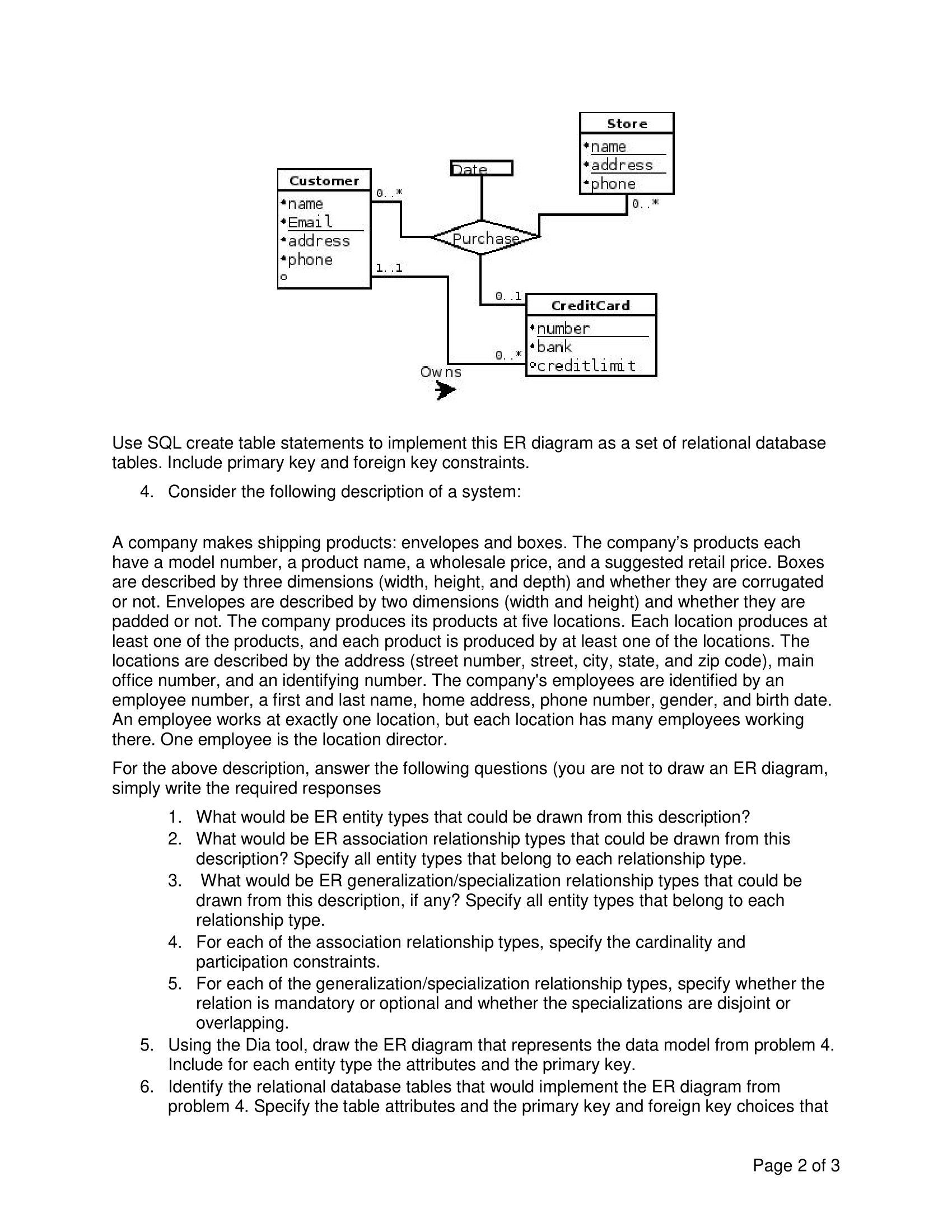Answered step by step
Verified Expert Solution
Question
1 Approved Answer
1. Using Dia, draw the ER diagrams to represent the relationship type suggested by each of the following scenarios. You do not need to


1. Using Dia, draw the ER diagrams to represent the relationship type suggested by each of the following scenarios. You do not need to include any attributes in your ER diagrams, only the entity type and relationship types. 1. There are two entity types: nurses and patients. Each nurse treats many patients and each patient is treated by many nurses. Each patient must belong to the relationship, but nurses on vacation do not have to belong to the relationship. 2. There are two entity types: students and professors. Professors have a set of students that they advised regarding course selection. Each student is advised by exactly one professor, but professors will typically advise many students. Some professors do not advise students at all. 3. There two entity types: boats and people in the park. People in the park rent the boats from the park. Each person in the park can rent one boat at a time, and each boat is rented to only one person in the park. A boat may or may not be rented, and people in the park to not have to rent boats. 4. There are three entity types: cameras, lenses, and photographs. A photograph is taken with one camera that has attached a single lens. But a camera can take many photographs using many lenses. A lens can be used on many cameras to take many photographs. 2. Consider the following ER diagram (primary keys are underlined): Room Durm De varchar(30) numRooms numere(3) address varchar (54) Belong To Roo bunked maric (3) boolman shared Bathrose boolean Resides in A Student Sid numeric(6) ane varchar(25) phone varchar(12) with Create the relational database tables required to implement this ER diagram using SQL create table statements. Include primary key and foreign key constraints. 3. Consider the following ER diagram (primary keys are underlined): Customer name *Email address *phone 0 0.. 1..1 Date Purchase Owns 0..1 0. * Store *name address phone Credit Card 0..* *number bank creditlimit Use SQL create table statements to implement this ER diagram as a set of relational database tables. Include primary key and foreign key constraints. 4. Consider the following description of a system: A company makes shipping products: envelopes and boxes. The company's products each have a model number, a product name, a wholesale price, and a suggested retail price. Boxes are described by three dimensions (width, height, and depth) and whether they are corrugated or not. Envelopes are described by two dimensions (width and height) and whether they are padded or not. The company produces its products at five locations. Each location produces at least one of the products, and each product is produced by at least one of the locations. The locations are described by the address (street number, street, city, state, and zip code), main office number, and an identifying number. The company's employees are identified by an employee number, a first and last name, home address, phone number, gender, and birth date. An employee works at exactly one location, but each location has many employees working there. One employee is the location director. For the above description, answer the following questions (you are not to draw an ER diagram, simply write the required responses 1. What would be ER entity types that could be drawn from this description? 2. What would be ER association relationship types that could be drawn from this description? Specify all entity types that belong to each relationship type. 3. What would be ER generalization/specialization relationship types that could be drawn from this description, if any? Specify all entity types that belong to each relationship type. 4. For each of the association relationship types, specify the cardinality and participation constraints. 5. For each of the generalization/specialization relationship types, specify whether the relation is mandatory or optional and whether the specializations are disjoint or overlapping. 5. Using the Dia tool, draw the ER diagram that represents the data model from problem 4. Include for each entity type the attributes and the primary key. 6. Identify the relational database tables that would implement the ER diagram from problem 4. Specify the table attributes and the primary key and foreign key choices that Page 2 of 3
Step by Step Solution
★★★★★
3.34 Rating (157 Votes )
There are 3 Steps involved in it
Step: 1
It seems you have given a multipart question that involves EntityRelationship ER diagrams and their implementation into SQL table creation Due to the nature of handling such questions the entire proce...
Get Instant Access to Expert-Tailored Solutions
See step-by-step solutions with expert insights and AI powered tools for academic success
Step: 2

Step: 3

Ace Your Homework with AI
Get the answers you need in no time with our AI-driven, step-by-step assistance
Get Started


